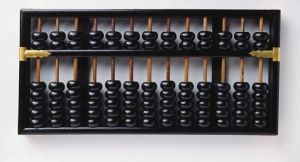Zhusuan
China's Zhusuan (珠算) is the knowledge and practice of arithmetic calculation using an abacus, with a history of over 1800 years. The Chinese invention is considered as the world's most ancient computer.
Before the age of calculators, this is what Chinese people used to do their sums. They would move the beads on the abacus following certain rules. Each bead in the upper deck equals five, those in the lower deck equals one.
A simple bamboo frame with moving beads on rods, the typical Chinese abacus is not just for addition, subtraction, multiplication and division but can cope with advanced operations such as roots and exponentials.
For centuries, the abacus was a major calculating device. It even helped to make calculations when China developed its first nuclear bomb in the 1960s.
Until the 1990s, abacus lessons were compulsory in primary schools; later they became a selective subject. And then it was totally removed from the curriculum.
But, abacus operation has developed into mental calculation. Some children learn this as an interest. Learners figure out results with an abacus in mind. And there are national contests.
Today, the abacus is still an auspicious symbol of wisdom and wealth. Three abacus and zhusuan museums in east and north China are attracting millions of visitors every year.
In 2008, it was listed as a national intangible cultural heritage. People in the abacus association hope the valuable heritage won't die.
On Dec. 4, 2013, the world's oldest computer was listed as Intangible cultural heritage of humanity at the 8th Annual UNESCO World Heritage Congress in Baku, Azerbaijan.
UNESCO's website says that zhusuan has played a vital role in mathematical studies, promoting algorithmic practices and fostering intelligence. Training in abacus arithmetic is thought to improve a child's attention span, memory and intellectual capability, as demonstrated by primary school kids in northeast China's Heilongjiang Province.
Zhusuan is following a similar route as calligraphy, which, on the UNESCO list since 2009, has moved from a tool of communication to what UNESCO describes as "an important channel for the appreciation of traditional culture and for arts education."
